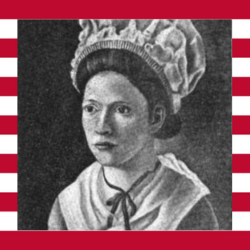
When people imagine spies today, they typically envision sauve agents, decked out in the most innovative gadgets their time could offer or dressed up in an outfit that perfectly conceals their identity from the enemy. Rarely, if ever, would they picture a young woman tucked away in a linen closet, holding her breath so should hear the murmuring of soldiers she had invited into her home—yet that is exactly what revolutionary spy Lydia Durragh did.
Born in 1729 in Dublin, the Irishwomen emigrated to Philadelphia in 1953 to become a private tutor and midwife for other families living within the British-occupied colonies. Lydia was a mother to four children herself, embracing values of Quakerisim in her personal life and thus was widely considered to be a pacifist. Her house, however, was situated across the street from the home of General William Howe, a British officer working as an overseer of the colonies. The militaristic operations that abutted her home forced Lydia to consider her own personal alliances and values, making her unable to deny her duty and space within the fight for American independence. Lydia knew she disapproved of the British occupation and their plans of conflict, and these convictions lead her to intentionally eavesdrop on the conversations of her neighbors and then have the information passed on to George Washington’s continental army. Her status as Quaker a woman undoubtedly helped this endeavor, as people often saw them as unthreatening or non-conflict oriented.
The information gathered by Lydia on the street, while impactful, was often a result of a casual conversation between officers, and thus did not have much potential to change the tides of battle. A new opportunity arose, however, when General Howe demanded that she be evicted from her home so that it could be occupied by soldiers in need of housing. She adamantly refused, and appealed so as to let the family remain in the home while the officers used it for classified meetings—it was a golden opportunity to pass information over to the revolutionaries. By putting her foot down and refusing to relocate her family, Lydia ensured that her family not only had secured housing but also created an environment in which she could listen in on classified British secrets.
On the evening of December 4th, 1777, British officers gathered in her home to discuss plans to ambush Washington’s army in Whitemarsh later that week. Instead of retiring early to bed at the request of the officers, Lydia stayed awake and listened in on the contents of the meeting, gathering all of the information she could on the contents of the ambush. Bravely, she discovered the plans of the British army and consequently saved the lives of many Continental Army soldiers. Her spying, though unglamorous compared to the sensationalized work of modern spies, illustrates a true act of bravery.
Simply hearing the information was half of the battle, however, as getting it across British lines proved to be another difficult task. Appealing to her position as a housewife and homemaker, officers granted her position to cross British lines to purchase flour. This innovative lie gave Lydia the chance to reach out to her contact in the continental army, Colonial Craig, and tell him the British’s plans of ambush. She used her status as a woman to her advantage and manipulated the unassuming troops into letting her carry sensitive information to their enemy
Lydia changed and saved lives, but her legacy does not come without sacrifice. Her assistance to the Continental Army got her membership in the Society of Friends, the Quaker organization she was deeply passionate about, revoked. However, following the war, Lydia’s legacy as a brave spy lives on, and her assistance to the Continental Army surely created a lasting impact on American history. Lydia Darragh exists as one of the brave women who helped shape the contours of America and create a path toward victory for the Continental Army.
